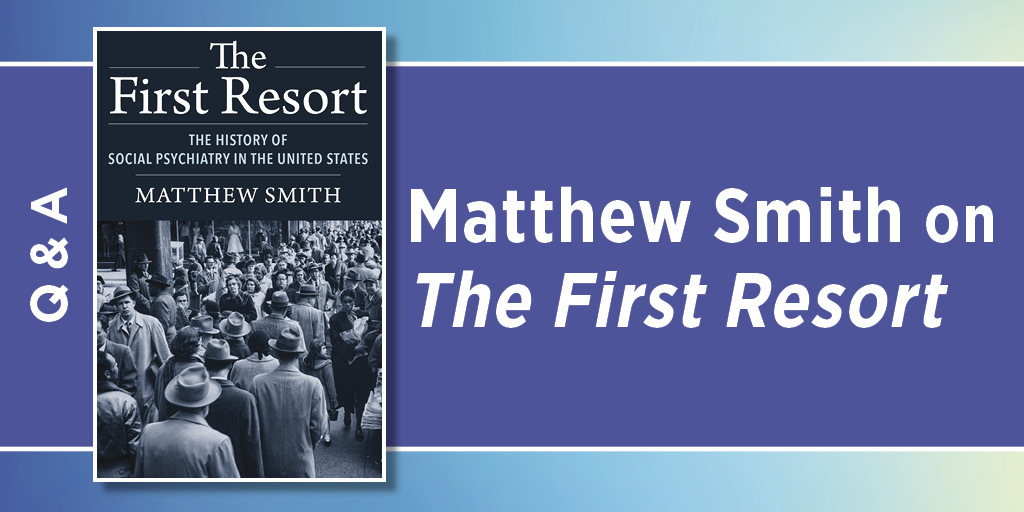Q&A: Matthew Smith on The First Resort

In the mid-twentieth century, social psychiatry was an approach to mental health that stressed the prevention of mental illness rather than its treatment. In the 1960s, it led to the closure of asylums and the emergence of community mental health prevention programs that considered socioeconomic backgrounds. However, by the 1980s, the practice was in decline. In The First Resort: The History of Social Psychiatry in the United States, Matthew Smith, professor of health history at the University of Strathclyde’s Centre for the Social History of Health and Healthcare, explores the lessons that this largely forgotten movement has to offer today.
Q: What is social psychiatry?
Matthew Smith: Social psychiatry was an approach to mental health that emerged during the middle of the twentieth century. It combined the insights of both social scientists and psychiatrists to investigate the socioeconomic determinants of mental illness. Nicknamed “a preventive psychiatry,” the ultimate task of social psychiatry was to develop preventive mental health strategies that would result in better mental health. Although social psychiatry had great political influence in the United States during the 1950s and 1960s, it is largely forgotten today.
Q: Why did you get interested in social psychiatry?
Smith: My interest was inspired by the research I did on the history of attention deficit hyperactivity disorder (ADHD). When I started exploring the origins of ADHD in the 1950s and 1960s I kept coming across articles that discussed social psychiatry. I had heard of psychoanalysis and biological psychiatry, but I had never read about social psychiatry. At the time, I was working as a youth counselor with the YMCA in Canada, and social psychiatry’s emphasis on the social determinants of mental health struck home. Many of my clients came from really tough backgrounds, but this was often forgotten as we attempted to pin the correct psychiatric diagnosis on them. Historians had also overlooked social psychiatry for the most part. After my work on the history of ADHD and food allergy (published by Columbia University Press), I felt compelled to give the story of social psychiatry justice. I won an Early Career Leadership Fellowship from the Arts and Humanities Research Council (UK) to take on the project and was off to the races.
Q: What did social psychiatrists discover about mental health?
Smith: They discovered what a lot of us know implicitly: that factors such as poverty, inequality, community disintegration, and social isolation are bad for mental health. As the major social psychiatry research projects studied very different places, ranging from New York City to rural Nova Scotia, they also found that local factors, including the relevant historical context, were important to consider. I think social psychiatrists also discovered (though they didn’t tend to articulate this) that it was much easier to identify the factors linked to mental illness than to do something about them. This is a lesson we still need to grapple with today.
Q: What sort of impact did social psychiatry have?
Smith: Social psychiatry had a mixed legacy. Its primary impact was to inspire the deinstitutionalization movement in the United States, in other words, the closure of asylums and the emergence of community mental health. Influenced by social psychiatry, community mental health centers were meant to be places where preventive as well as clinical work was done. But such preventive work was hard to achieve in practice without significant social changes to tackle poverty, inequality, racism, and social disintegration. By the 1980s, federal-government funding for community mental health was shrinking, and social psychiatry was soon a thing of the past. Ironically, many people with mental health problems became homeless, facing an even more desperate socioeconomic situation than ever before.
Q: What can the history of social psychiatry teach us today?
Smith: The real lesson of social psychiatry is that we overlook the socioeconomic determinants of mental health at our peril. If we really want to tackle our ongoing mental health crises, we need to come up with bold initiatives to tackle poverty, racism, inequality, social isolation, and community disintegration. In the book I argue that universal basic income (UBI) could be the ideal platform for such a preventive mental health strategy. UBI would lift people out of poverty and allow them the opportunity for social mobility via education, entrepreneurial activities, or career changes. It would free people up to engage more meaningfully with their communities and help to tackle other pressing problems, such as climate change. Interestingly, a version of UBI was recommended in 1969 in one of the final mental health reports that was infused with social psychiatry, but it came to nothing. Today, with more people interested in UBI than ever before, perhaps we finally have the chance to develop a preventive mental health strategy fit for the twenty-first century and inspired by social psychiatry.






